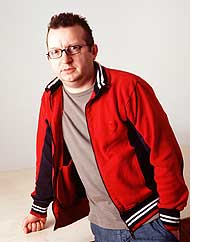Turnage interview about new ensemble works

Crying Out Loud and No Let Up, a vigorous pair of new ensemble works by Mark-Anthony Turnage, are premiered in Frankfurt and Chicago in the coming months.
With Crying Out Loud you’re working again with Ensemble Modern, following close collaborations on Greek and Blood on the Floor. Can your knowledge of a group influence the piece you write?
Knowing the band so well as individuals makes a big difference. When you’re writing lines for particular instruments you always think of the person who’ll be playing them. I know they’re a close-knit group with amazing virtuosity and that means I can write difficult things and they’ll have no problems playing them. Also, being aware from the start that Oliver Knussen would conduct gave me confidence, because I know that he hears everything and can try and make sure each note is just right.
When did the title Crying Out Loud appear and what does it signify?
Titles always come at the start of the process for me. I decided on the title because I wanted to write something loud and extrovert. I’d done quite a few chamber pieces with lyrical and reflective music and I wanted a change. So once the title was in place the work grew from there. I dedicated the piece to my two sons who did a fair amount of crying out loud when they were little, but this was more of joke really, and it didn’t play any part within the piece itself.
Is the minimal contrast within the piece intentional?
Definitely. My normal way of working would be to have loud and fast sections followed by contrasting, contemplative material. But here I wanted to keep the same mood throughout. So all the way through it is hard-edged and dark, almost nasty.
But as well as the fast and manic music, you mark some sections as lyrical and bell-like?
Even here, though, it is the percussive, struck sound of a bell I’m after, and the crying comes from the way the sound rings on.
Although there were intervening works between the two compositions, No Let Up seems to explore the same dark territory?
Yes, though it’s just by chance that two hard-edged works ended up having premieres so close. The title No Let Up implies a single-minded determination and I tried to write something against the tradition of lots of other music, including my own. Instead of goal-orientated sections, which collapse into repose and then start building again, I wanted a piece that drove right through in a single sweep.
There’s quite a lot of repetition in the rhythm and accentuation here.
Yes, more than usual for me. I used to have a hang-up about repetition, just the same as I didn’t want to use key signatures. I even used to write out the repetitions in full so I didn’t appear to be using repeat marks. Here the repetitive elements give the work the relentless mood I was after. The composers I’m most interested in listening to these days, certainly of the modern stuff, are those that are totally single-minded. For example I love Andriessen’s harder-edged pieces and also music by Morton Feldman - and you couldn’t get a more different pair of composers. But, for both of them, in many of their pieces creating contrasts is not a central issue. I like the way their music can just carry straight on.
There are pairs of instruments working together.
That’s right - two soprano saxophones and two bass clarinets. I like using distinctive pairs in this way because they can really buzz off each other. The scoring as a whole, for 11 instruments without strings, expands that of an earlier work, Release, which the Chicago Contemporary Music Ensemble already has in its repertoire. So, when the group commissioned a new work, I intended No Let Up to be something of a companion piece.
How is writing for an ensemble different to that for an orchestra?
It has to be more personal. I’ve been very lucky having extended residencies with the City of Birmingham and BBC Symphony Orchestras but, however hard you try, it is impossible to really get to know 80 plus people at a close level. That said, musically it doesn’t make a great difference to the way I write. Anything below seven or eight players is chamber music for me, but once you’re beyond this I tend to think orchestrally. The instruments within the ensemble can work in blocks just like in a larger score. What I’m really after, is that big orchestral sound.
(Interviewer: David Allenby)
Crying Out Loud (2003)
Premiere: 26 March 2004 Alte Oper, Frankfurt
Ensemble Modern
conducted by Oliver Knussen
2(II=picc).1(=corA).2(I,II=bcl).asax(=ssax).1—2.1.1.0—perc—harp—pft—strings(1.0.1.2.1)
Duration: 15 minutes
No Let Up (2003)
Premiere: 15 February 2004 Symphony Hall, Chicago
Chicago Symphony Contemporary Music Ensemble
conducted by Cliff Colnot
1.0.2ssax.2bcl.0—1.1.1.0—dr—pft—bass gtr
Duration: 10 minutes
> Further information on Work: Crying Out Loud
Photo: Hanya Chlala/ArenaPAL
